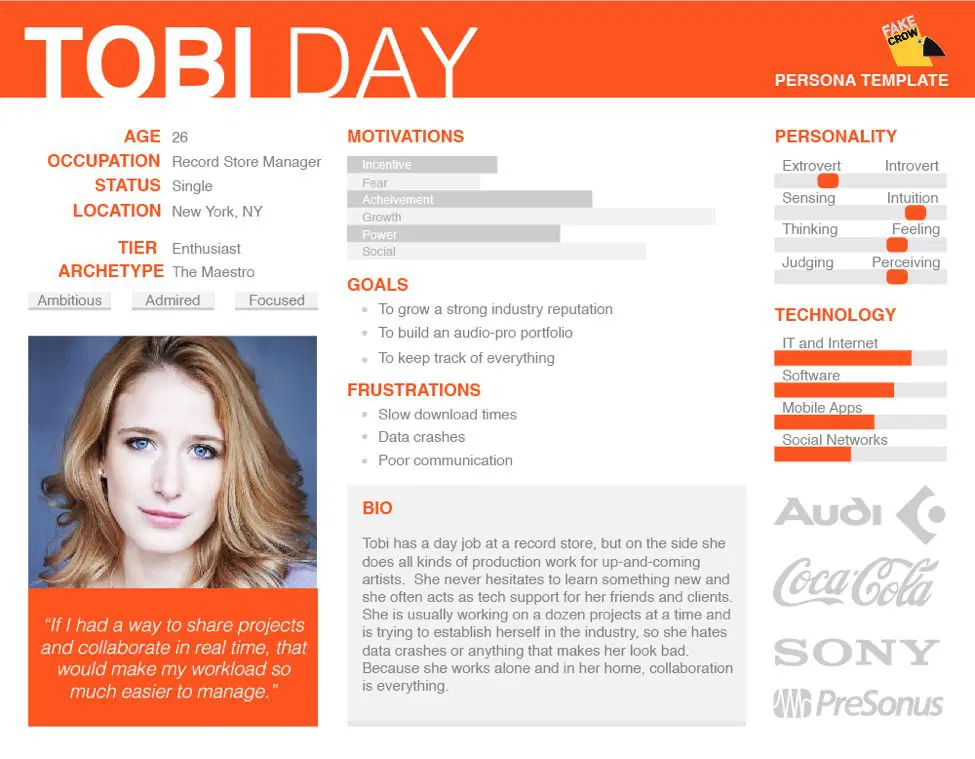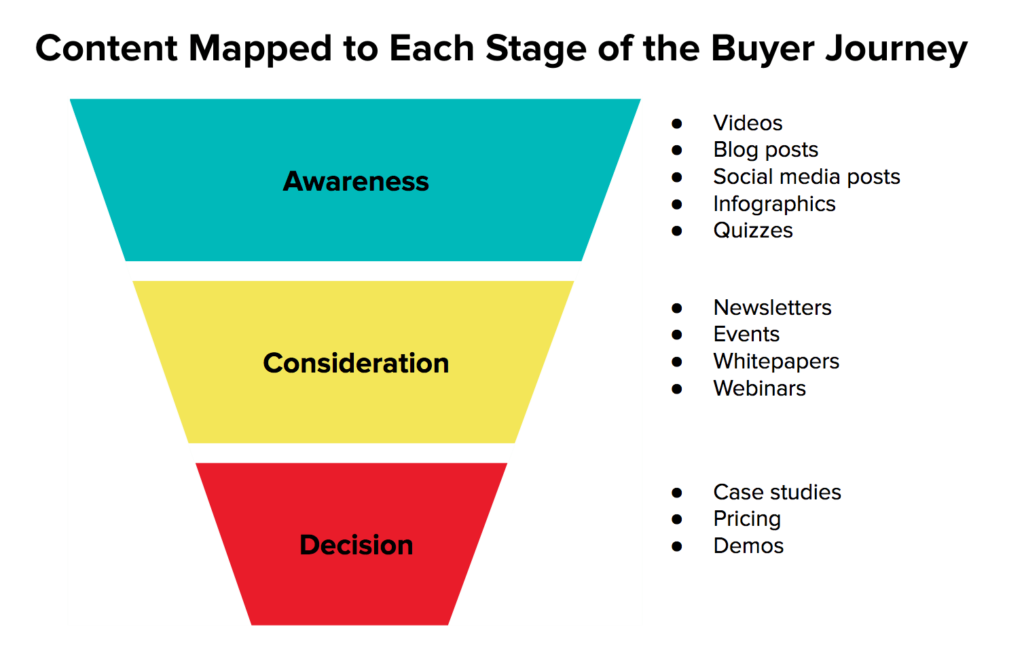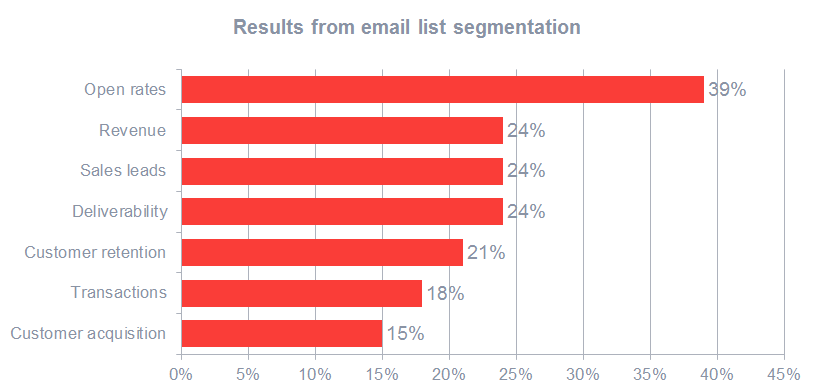The average person views anywhere from 5,000 to 10,000 ads every day. Marketing campaigns need to go above and beyond to get attention and stand out from this crowd of advertisements. One strategy for doing this is to target your campaign to segmented audiences so your content gets seen by the right people at the right time.
This strategy is called persona marketing, where marketers first take the time to build customer personas, semi-fictional representations of ideal customers based on their interests, motivations, challenges, and lifestyles.
Using customer personas in your marketing can make websites 2-5 times more effective and easier to use by your targeted customers. In fact, cloud automations company Skytap focused on persona marketing and found their sales leads increase by 124%, online leads by 97%, and organic search traffic by 55%.
Since customer personas are essential to this shift in how you plan your marketing campaigns, let’s take a look at what customer personas look like.
A Quick Look at How to Build Customer Personas

As you see in the persona example above, each customer persona is given a fictionalized name and image. The information included about each persona is put together based on actual or prospective customers. It can take a bit of time, but there are only a few steps to building customer personas.
Step 1: Choose Your Categories
The categories you include for each persona will vary depending on your product or service, but in general, these are the basics you will cover:
- Demographics: Age, location, occupation, income
- Lifestyle: Interests and hobbies, day to day activities
- Media: Trusted sources of information, what social media they use
- Motivations/Objectives/Goals: What drives their buying decisions, what goals to they want to accomplish in their lives?
- Brands: What brands do they support/use already?
- Pain Points/Frustrations/Challenges: What problems do they have that they need help solving? What challenges do they face in their daily home/work life?
- Objections: What are frustrations they’ve had with related products or services?
Quick Tip: If you are a B2B, the customer persona will be focused more on who the buyers in your targeted companies are, what there purchasing power is, job titles, company details, and other information about how buying decisions are made in txhat type of company. B2C personas will include personal details, including day-to-day behaviors and hobbies.
Step 2: Research, research, research!
There are many resources at your disposal for learning about your customers. Since the purpose of persona marketing is to personalize your content, you must start by talking to your actual customers. You can meet with customers in person, over the phone, or through detailed surveys. Some companies run small focus groups, which can also be an effective way to learn more about customers.
When planning interview questions, keep in mind the categories that are found commonly in customer personas: demographics, lifestyle, media, goals, brands, pain points, and objections. Focus your questions on what makes the most sense for your product or service, and keep questions open-ended and non-judgmental.
Beyond talking to the customers, there are some excellent online research resources. To learn about customer interests, track what topics people are sharing and posting. Tools will analyze which customers are spending their time on social media, and where they tend to visit.
Google Analytics is another great tool for getting data about who is visiting your website and what search terms they are using to get there. Keywords can be a big help when you are looking at what terms to include in your campaigns, and these can be added to your personas.
In addition to digital tools, there are people in your company who already know a lot about your customers: sales and customer success teams. In performing their jobs, they have learned a lot about your customers specific challenges, motivations, and interests. Take what they share with a grain of salt, as marketing objectives vary slightly from sales objectives, but don’t neglect to ask for their input, as they are customer-facing and may have a lot of valuable insights.
Step 3: Putting it together
Once you’ve got all the data you can handle, it’s time to put it together. After interviewing customers, looking at analytics, and talking to other teams in your company, some patterns should start to emerge that can help you segment your customers in 2-6 groups.
Each segmented group should then be turned into a fictional portrayal of a customer, including giving them a name and a face. Once your persona has a name, it’s time to add what you’ve learned about each segmented group. Depending on your product or service, you will add categories similar to what you used while interviewing: demographics, lifestyle, pain points, motivations, interests, and goals.
Some marketers like to include actual customer quotes or ideas for solutions/strategies to use when marketing to that persona. Whatever categories you use, make sure the text is clear and legible. It should fit onto one page, or possibly on one image.
Zight (formerly CloudApp) is a great way to build and share your completed customer persona. Zight (formerly CloudApp)’s screen recorder brings screen capture, annotated screenshots, and GIF creation to the cloud in an easy-to-use app so you can quickly create visual content.
In addition to providing tools to create customer personas, we help marketing teams:
- Create eye-catching visual content to capture your audience’s attention
- Securely save your content in the Cloud and share with the team
- Optimize campaign workflows by using screenshots, GIFs, and videos to deliver feedback, as well as share campaign performance and lead generations
- Find your content quickly with the Visual Search feature
Whatever the tool you use to build your customer persona, it should be visually appealing and easy to share with audiences throughout your company. Once you have your personas completed, it’s time to plan your persona marketing campaigns.
Persona Marketing Strategies
Persona marketing is a great way to personalize your campaigns and ensure that your work is seen by the people you want to see it, where they will see it. Customer personas will also help you to plan content that brings value to your customers, drawing their attention and bringing value to them in a way that will bring revenue, leads, and more.
Some strategies that are elevated by using personas include content marketing, email campaigns, messaging, and social media.
1. Content Marketing

Often, marketers can get caught up in what content they feel is important to share. But to be relevant and effective, it is best to focus on what your customers need. Since personas include important information about customers’ challenges, needs, and interests, customer personas should be the starting point to plan your content.
One method of organizing your content is to use your personas and plan out what needs or pain points they have throughout the customer journey—awareness, consideration, and decision. You can then position your product or service to show how it can meet their needs and provide a solution.
In the first stage, awareness, customers aren’t ready to purchase, so it is mostly about getting information in front of them to expose them to your product. Content at this stage include writing blog posts, using influencers on social media, or creating short videos or infographics. Mostly you want to get attention where your customers are hanging out online, so pay particular attention in your personas to: media, interests, and keywords.
The next stage in the buying process is consideration, where the customer is more aware that there is a problem, and they may be starting to research possible solutions. The content you provide here should educate the customer on how you compare to your competitors, so on your personas, pay attention to brands they already follow and where they go for trusted information. This way, you can position your white papers or pamphlets where customers will see them, in formats they prefer.
During the decision stage, it’s time to convert your customer into a buyer. You can continue to educate the customer on your product, but this is also a good step to offer demos, freemiums, and any information that convinces them that your company offers the best solution to their problem.
Zight (formerly CloudApp)’s visual communication software provides easy-to-use tools that make it easy to create enticing visual content throughout all stages of the buying cycle, including:
- Annotated screenshots to highlight special product features
- Short videos using screen capture and webcams to introduce customers to your product or service
- How-to GIFs that draw attention on social media
Using personas allows you to target all of your content to specific segmented audiences to stay within your marketing budget and get the most out of your promotion dollars by ensuring the customers who you want to see your content, see it.
2. Messaging
When you are writing your content, you must continue to keep your customer personas in mind. Personas will humanize your sales and marketing messages because they should include the types of language that your different customers prefer. That means including key words and phrases for each of your personas, including specific vocabulary, especially in B2B, where each industry tends to have their own acronyms and buzz words.
3. Email Campaigns

Once you’ve planned content to reach your different personas, you must then ensure that it gets seen by the right people. Using CRM tools like HubSpot, you can assign personas to your prospects, which will allow you to email customers based on their persona.
That way, both your content and emails are targeted to different personas, and their position in the customer journey. This can have a huge impact on the success of your email campaigns. In one case, SuperOffice managed to get a 94% open rate from emailing a segmented list versus the same email to their whole list.
Understanding your buyers and organizing them by their personas is the perfect way to target email campaigns to get higher open rates and funnel them toward buying.
4. Social Media
Personas help you plan out where to most effectively promote your content. When researching customer personas, you have already done the work of figuring out where customers tend to hang out online and where they go for trusted information. This is an essential step because your content could be exceptionally valuable to customers, but they won’t see it if you don’t put it where they hang out.
Improve ROI With Persona Marketing
Although it takes a lot of time upfront to research and build customer personas, the payoff is limitless. When you make the switch to persona marketing, it is easier to focus your marketing budget and resources to providing valuable content to your ideal customers.
Learn more about Zight (formerly CloudApp) for Marketing here.
